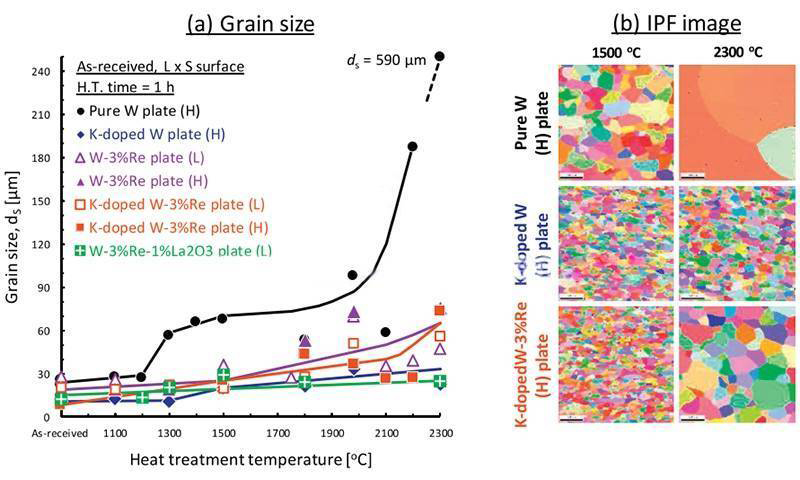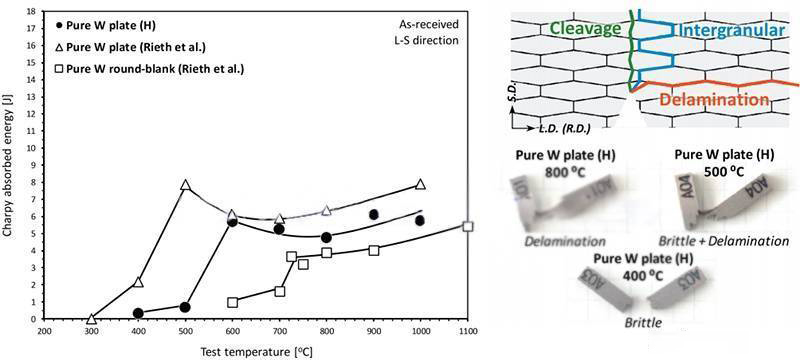Email:
sales@hypersolidmetal.comWhatsapp:
8618625975081
Email:
sales@hypersolidmetal.comWhatsapp:
8618625975081The ductile-brittle transfer temperature (DBTT) of modified tungsten materials can be evaluated by several test methods, such as tensile test, bending test, Charpy impact test, and fracture toughness test.The DBTT depends greatly on the test method, strain rate, and specimen shape. Among them, some researchers use Charpy impact and tensile tests to evaluate DBTT.
The Charpy impact test is performed according to EU standards using KLST Charpy V-notched specimens in the L-S (plate) and L-R (rod) directions in a vacuum at temperatures ranging from 200 to 1000°C (first letter (L): direction perpendicular to the expected crack plane, second letters (S and R): direction of expected crack growth).

Annealing temperature dependence picture of grain size along the S direction for pure and modified tungsten materials
Even though the modified tungsten materials have the same primary chemical composition, the DBTT and upper shelf energy (USE) vary with the materials, which have undergone different fabrication methods and histories (e.g., deformation rates).
Most of the materials showed a mixture of brittle fracture and brittle and delamination fracture below DBTT and delamination fracture above DBTT. In contrast, the K-doped W rods showed ductile deformation with little or no cracking above 800 °C. The DBTT vs. grain size (dS) and USE vs. grain size (dS) relationships were of the Hall-Petch type. Those different DBTT and USE, therefore, cannot be determined by the main chemical composition alone, but may be due to individual special grain structures depending on the manufacturing method and history.
The DBTT is 550°C for pure W(H) plates; 350°C for K-doped W(H) plates; 450°C for W-3% Re(H) plates; 550°C for W-3% Re(L) plates; 250°C for K-doped W-3% Re(H) plates; and 550°C for W-3% Re-1% La2O3(L) plates. For the highly deformed material (“H”), K-doping and Re-addition resulted in a decrease in DBTT of about 200 and 100 °C and an increase in USE of about 40 and 30%, respectively.
In contrast, W-3%Re(L) and W-3%Re-1%La2O3(L) plates show very low absorption energies compared to the highly deformed material. No significant positive effect of La2O3 particle dispersion was observed in the low deformation material. The appearance of the test specimens showed that the delamination in the low-deformation material expanded rapidly with little plastic deformation of the base metal, while the high-deformation material showed delamination accompanied by sufficient bending (plastic deformation). These results suggest that Charpy impact properties can be improved by K-doping and Re-doping when sufficient deformation is applied during rolling and forging.

Experimental temperature dependence picture of absorbed energy of Charpy impact test for KLST specimens
Furthermore, a synergistic effect of K-doping and Re-doping is clearly observed. In contrast, the dispersion effect of La2O3 particles needs to be clarified in future work by applying it to highly deformed materials.
Reference source: China tungsten Online